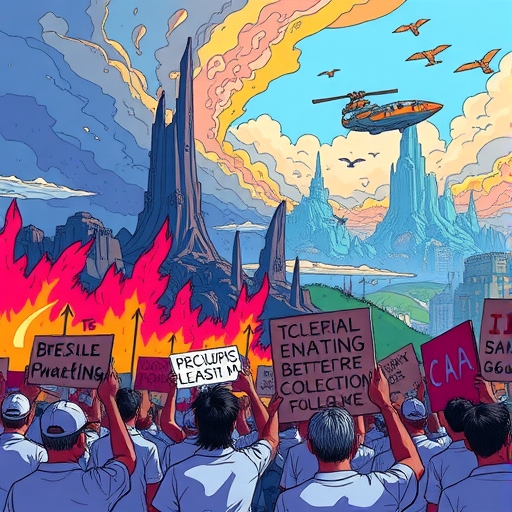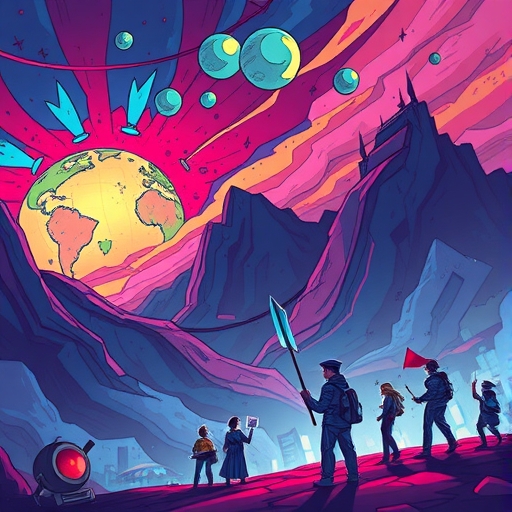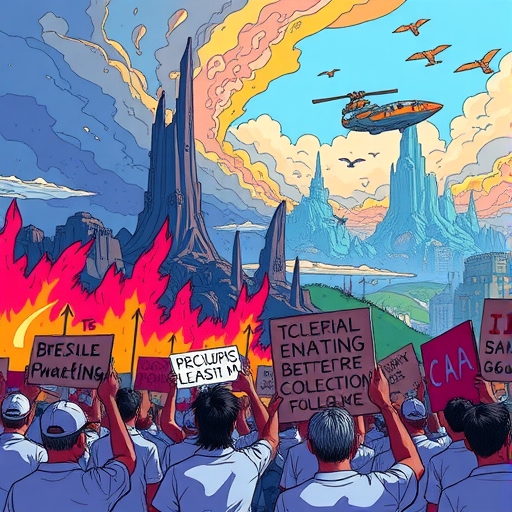Welcome, aspiring investors and seasoned traders. Today, we turn our analytical lens towards a sector that, while often viewed purely through the lens of entertainment, presents a fascinating case study in market dynamics, consumer behavior, and the complex interplay between creativity and commerce: the video game industry. Valued in the billions, it might seem like an unstoppable force. Yet, beneath the surface of blockbuster releases and esports spectacles, significant challenges are mounting. This environment, while specific to gaming, offers valuable lessons applicable to understanding market health and potential corrections across various sectors. Let’s explore the intricate forces at play, understanding why many observers believe the industry is overdue for a period of “tightening.”
Just as you might scrutinize financial statements or chart patterns in traditional markets, understanding the underlying health of an industry requires looking beyond headline revenue figures. We must delve into the operational costs, consumer sentiment, labor conditions, and long-term sustainability of prevailing business models. In gaming, this means examining everything from how games are made and sold to how players feel about their purchases and interactions.
What exactly do we mean by “tightening”? In this context, it refers to a potential phase of consolidation, stricter practices, or even a market correction that forces companies to become leaner, more efficient, and perhaps more attuned to fundamental consumer desires, moving away from potentially unsustainable or unpopular strategies. It’s about the market self-correcting or being forced to correct its course.
Think of it like an overextended portfolio. When assets are overvalued, and underlying fundamentals weaken, a correction becomes increasingly likely. The gaming industry, despite its apparent size, exhibits symptoms that suggest similar pressures building. We will unpack these symptoms, guided by recent data and observations from within the industry itself.

For years, the gaming industry enjoyed robust growth, fueled by expanding global markets, the rise of mobile gaming, and the increasing mainstream acceptance of gaming as a form of entertainment. However, recent reports suggest this growth trajectory is facing headwinds.
The Duamentes Gaming Report, for instance, indicates that market growth has, at least temporarily, stopped. While a projected valuation of $189.3 billion in 2025 is undoubtedly immense, a lack of continued expansion year-over-year signals a potential saturation point or, more critically, underlying issues preventing further organic growth under current conditions. It’s akin to a company whose revenue plateaus – a sign that existing strategies might no longer be effective in capturing new market share or increasing per-user spending sustainably.
This comes at a time when the cost of doing business in the gaming sector is skyrocketing. Developing modern, high-fidelity games, particularly the so-called “AAA” titles, requires enormous budgets, often stretching into the hundreds of millions of dollars. Marketing costs are also substantial, necessary to cut through the noise in an increasingly crowded market.
When growth stalls but costs continue to climb, profitability comes under immense pressure. This financial strain is not just theoretical; it manifests in concrete, often painful ways for the people working in the industry.

Perhaps the most stark indicator of financial distress in the gaming industry has been the wave of studio closures and layoffs that have swept across major markets, particularly in the US and Europe, over the past year or two. While some might attribute this solely to a post-pandemic normalization after a period of accelerated growth, the scale and breadth of these job losses suggest deeper systemic issues.
Thousands of talented developers, artists, producers, and support staff have been laid off. Entire studios, some with long histories, have been shut down. This isn’t merely belt-tightening; it signals that many companies, even large ones, are finding their current operational structures and project pipelines unsustainable in the face of high costs and uncertain market returns.
Consider the context: these layoffs occur despite the market’s multi-billion dollar valuation. This disconnect highlights a fundamental challenge: while the industry generates vast sums, the economic model for many individual projects and studios appears fragile. High production costs mean that a single commercial failure can be devastating, and in a market struggling for growth, failures are becoming more common or more impactful.
From an investment perspective, widespread layoffs can indicate a lack of faith in future growth projections, a necessity driven by unsustainable debt or spending, or a strategic pivot away from costly, high-risk ventures. It forces us to ask: if the industry is so large and successful, why are so many of its skilled workers losing their jobs?
| Indicator | Description |
|---|---|
| Studio Closures | Major studios shutting down operations due to financial distress. |
| Layoffs | Thousands of developers losing jobs across the industry. |
| Economic Fragility | High production costs leading to unsustainable economic models. |
Adding to the financial strain are prominent examples of big-budget games that have underperformed or outright failed commercially. These are not obscure indie titles; these are games from major publishers with significant marketing pushes and expectations.
Titles like Suicide Squad: Kill the Justice League have been reported to incur significant financial losses, potentially exceeding $200 million. While the specifics can be debated, the sheer scale of the investment and the subsequent return (or lack thereof) underscores the immense financial risks inherent in the AAA game development model today.
Other games, though perhaps not suffering losses of that magnitude, have also struggled to find a sustainable audience or meet publisher expectations. The anticipation surrounding titles like Concord and XDefiant was high, yet their initial performance or subsequent challenges in retaining players highlight how difficult it is to launch and maintain a successful game in the current climate.
Why do these expensive bets fail? It’s a complex question with many potential answers, but data suggests several contributing factors:
- Market Saturation: The sheer volume of games released constantly makes it harder for any single title to capture and hold attention.
- Changing Player Expectations: Players are savvier than ever, demanding high quality, innovative gameplay, and respecting their time and money.
- Execution Issues: Technical problems, poor design choices, or misjudged monetization strategies can doom a game regardless of its budget.
- Live Service Challenges: Many high-budget games are designed as live services intended to retain players for years, but building and maintaining an engaging, evolving service is incredibly difficult and expensive.
These failures aren’t just bad news for publishers; they send ripples through the industry, increasing pressure on developers, leading to cautiousness or risk aversion, and contributing to the overall sense of financial instability.

Beyond the financial metrics of market size and game sales lies perhaps the most critical challenge: player satisfaction and retention. What happens after a player buys or downloads a game?
Alarming statistics reveal a significant disconnect between the games being offered and players’ willingness to stick with them. Reports indicate critically low player retention rates, with staggering numbers: 70% of players may quit within their first few sessions, and a remarkable 92% may drop off before hitting the 30-day mark.
Think about that from a business perspective. Imagine any other product or service where over two-thirds of your customers abandon it almost immediately, and over 90% are gone within a month. This isn’t just poor performance; it’s a fundamental failure to engage and retain the audience.
Why are players leaving so quickly? The reasons are multifaceted:
- Poor First Impression: Technical issues, confusing interfaces, or unengaging early gameplay can turn players off instantly.
- Repetitive Gameplay: Many games, particularly in crowded genres or live services, struggle to offer enough novelty or meaningful progression to keep players hooked.
- Misaligned Monetization: Aggressive or perceived unfair microtransactions or DLC practices can alienate players and erode trust.
- Lack of Emotional Connection: In a vast digital landscape, games that fail to forge a compelling narrative or foster a sense of community struggle to retain players.
- Ignoring Feedback: Studios that don’t effectively listen to and act upon player feedback risk creating experiences that feel out of touch.
Low retention rates directly impact the profitability of games, especially those reliant on ongoing engagement and in-game spending. It suggests that the current focus for many titles may be on acquisition (getting players to buy) rather than retention (making them want to stay and spend). This is a key factor driving the need for the industry “to tighten” its focus back onto core player experience.
| Retention Rate | Percentage |
|---|---|
| Players quitting within first sessions | 70% |
| Players dropping off before 30 days | 92% |
| Players returning to games | Variable (% not specified) |
Player dissatisfaction isn’t just resulting in low retention; it’s fueling a growing demand for greater transparency, fairness, and consumer protection. This sentiment has crystallized in proposals like the “Gaming Industry Consumer Bill of Rights.”
This proposed framework outlines specific principles aimed at addressing some of the most contentious issues between players and publishers. It reflects a desire for clear standards and accountability in areas where players feel exploited or neglected.
What sorts of rights are being advocated for? The proposal touches on several critical points:
- Remaster Availability: Ensuring that when a remastered version of a game is released, players who owned the original retain access to it, rather than having the original delisted.
- DLC Pricing Limits: Suggesting that downloadable content (DLC) should have a reasonable price cap, perhaps not exceeding 50% of the base game’s price, to prevent excessive nickel-and-diming.
- Microtransaction Prohibition: A strong call to ban microtransactions entirely in single-player games, arguing they disrupt the core experience (excluding significant story-based DLC).
- Transparent Microtransaction Pricing: If microtransactions exist (in multiplayer/live service), mandating that prices are displayed in real currency rather than requiring players to convert to premium in-game currencies, alongside fixed conversion rates.
- Guaranteed Game Access: Stipulating that players should retain access to games they have purchased digitally, even if servers for online features are shut down, allowing for offline play where feasible.
- Clear Server Shutdown Dates: Requiring publishers to provide ample, upfront notice (e.g., 6 months) before shutting down game servers, giving players time to enjoy the online components they paid for.
- Mandatory Demos: Suggesting that games priced above a certain threshold (e.g., $50+) should be required to offer a playable demo (perhaps 10% content limit) to allow players to assess quality before purchasing.
- Optimization Marking: Calling for a clear system to indicate a game’s state of optimization at launch, setting realistic expectations for performance.
These points represent a direct response to practices that have eroded player trust over the years, from games launching in poor technical states (“broken games”) to aggressive monetization models perceived as prioritizing profit extraction over player enjoyment. The mere existence of such a detailed proposal, circulating widely in communities like Reddit and NeoGAF, signifies the depth of player frustration and the growing pressure for the industry to change, to “tighten” its ethical and business standards.
The pressures on the gaming industry aren’t confined to the financial reports and player forums; they are deeply felt by the people who actually make the games. Developers face their own set of significant challenges, often working under intense pressure in environments marked by instability.
Developer sentiment surveys reveal widespread issues, including:
- Burnout: The demanding nature of game development, especially during crunch periods leading up to release, leads to high levels of burnout among staff.
- Long Working Hours: Significant portions of the workforce regularly work excessive hours. Data suggests that as high as 46% of developers work over 50 hours per week, a figure far exceeding norms in many other industries.
- Job Insecurity: Despite the industry’s overall value, individual jobs feel increasingly precarious due to frequent layoffs and studio closures.
- Lack of Work-Life Balance: The demanding culture often makes it difficult to maintain a healthy personal life.
| Issue | Impact on Developers |
|---|---|
| Burnout | Increased mental health issues, decreased productivity. |
| Long Working Hours | Negatively impacts work-life balance and personal health. |
| Job Insecurity | Resulting in decreased morale and motivation among staff. |
The pressure extends to the development process itself. Many studios delay critical user testing until very late in the development cycle, with 71% reportedly waiting until beta phase. This increases the risk of launching with significant bugs or fundamental design flaws that could have been identified and fixed earlier, contributing to the “broken games” issue that frustrates players.
The human cost of these practices is significant. It not only impacts the well-being of developers but can also stifle creativity and lead to less polished, less innovative games. A “tightening” of the industry should ideally also involve a tightening of standards around development practices and worker welfare, fostering healthier and more sustainable creative environments.
Part of the reason for the industry’s current struggles lies in outdated practices that haven’t kept pace with evolving technology, player expectations, and the sheer volume of competition. The Duamentes report and other industry analyses point to areas where studios need to adapt.
One key area is the development process itself. The traditional “waterfall” model of development, where testing and feedback loops are heavily weighted towards the end, is proving insufficient. Recommendations include:
- Early and Frequent User Testing: Engaging players or dedicated testers throughout the development cycle to catch issues and refine mechanics early.
- Listening to Player Feedback: Actively soliciting, analyzing, and acting upon feedback from alpha, beta, and early access periods.
- Adopting Modular Systems: Building games using flexible, modular architecture that allows for easier updates, content additions, and adaptation based on player behavior.
Beyond development, business and monetization strategies require critical re-evaluation. The heavy reliance on live service models and aggressive microtransactions, while profitable for some breakout hits, contributes to the overall player dissatisfaction and low retention rates seen across the board. Players are increasingly wary of models that feel extractive rather than additive to the core game experience.
The rise of platforms like TikTok and short-form content is also influencing player behavior and content consumption. Players have shorter attention spans for unengaging experiences and demand immediate gratification or clear, achievable goals. Games that fail to adapt their onboarding and early-game experience to this reality risk losing players within minutes.
For the industry to truly “tighten” and thrive, it needs to move beyond chasing perceived trends (like every game being a live service) and instead focus on creating compelling, polished experiences that respect the player’s time and money. This requires a fundamental shift in mindset, potentially moving away from models heavily reliant on constant, potentially manipulative engagement.
Given the confluence of financial strain, player dissatisfaction, and developer challenges, a potent, albeit extreme, perspective has emerged: that the industry is overdue for a significant downturn, a “market crash,” to force a fundamental reset.
This sentiment, visible in forums like NeoGAF, argues that the current state is fundamentally unhealthy. It suggests that years of prioritizing short-term gains through aggressive monetization, rushing unfinished games to market, and focusing on endlessly repeatable “live service” loops have eroded the core values of creativity, quality, and player-centric design.
Proponents of this view argue that only a severe economic shock can truly force publishers and developers to re-evaluate their priorities. A crash would dry up investment, reduce budgets, and potentially make the high-risk, high-reward AAA model less feasible. This, they contend, could lead to a refocus on smaller, more innovative projects, better development practices, and a renewed emphasis on simply making good, complete games that players enjoy and trust.
It’s a harsh prognosis, with significant potential downsides, including more job losses and reduced overall market size. However, the fact that this perspective is gaining traction highlights the depth of the perceived problems. It reflects a frustration that incremental changes or self-regulation may not be enough to steer the industry away from what some see as a self-destructive path.
Whether a crash occurs or the industry manages a more controlled course correction, the underlying issues demand attention. The market forces at play, driven by unsustainable costs and profound player alienation, suggest that the status quo is untenable in the long run.
The challenges facing the gaming industry are significant, but they also present an opportunity for recalibration and growth. How can the industry navigate these turbulent waters and build a more sustainable future?
| Pathways | Description |
|---|---|
| Prioritizing Quality Over Quantity | Focusing on developing fewer, but higher-quality titles. |
| Rethinking Monetization | Exploring less intrusive alternatives to aggressive microtransactions. |
| Investing in Mid-Tier Development | Fostering diverse and innovative experiences with sustainable models. |
The success of games like Baldur’s Gate 3 (BG3), which eschewed many common live service and monetization pitfalls in favor of deep gameplay and player freedom, serves as a powerful example of what is possible when development prioritizes player experience and creative vision. Such successes demonstrate that there is a strong market appetite for games that respect the player.
Ultimately, the industry’s ability “to tighten” and correct course will depend on the willingness of publishers and developers to learn from past mistakes, adapt to changing realities, and rebuild the trust that has been eroded with a significant portion of its audience. This isn’t just about making better games; it’s about fostering a healthier, more ethical ecosystem.
While our focus has been on the gaming industry, the dynamics we’ve discussed offer valuable insights applicable to analyzing other markets and making investment decisions. The gaming sector serves as a microcosm demonstrating how:
- Market Saturation can lead to stalled growth even in large industries.
- High Costs and Low Retention create significant financial strain, regardless of gross revenue.
- Consumer Sentiment and Trust are critical, and their erosion can signal deep underlying problems.
- Unsustainable Business Models, even if profitable in the short term, can lead to long-term instability and calls for correction.
- Labor Conditions can impact the quality and consistency of output.
Just as you would analyze a company’s balance sheet, cash flow, and management team, understanding the health of an industry requires looking at these broader factors: the relationship with its customers, the sustainability of its operations, and the well-being of its workforce. A market facing player exodus, developer burnout, and financial failures on expensive projects is flashing warning signs that any astute observer should heed.
As investors and traders, our goal is to identify value and manage risk. Recognizing when an industry or sector is facing fundamental challenges, like the “tightening” pressures in gaming, is a crucial part of that process. It allows us to approach opportunities with caution and perhaps identify companies within that sector that are better positioned to navigate the difficulties or even lead the necessary changes.
The video game industry stands at a crossroads. The combination of stalled market growth, mounting financial pressures evidenced by layoffs and game failures, deep and widespread player dissatisfaction leading to alarming retention rates, and significant challenges faced by developers paints a picture of an industry in need of significant change. The calls for a “Consumer Bill of Rights” and the discussions around a potential market “reset” highlight the urgency of the situation.
The current climate, characterized by high costs, intense competition, and an over-reliance on potentially extractive business models, appears increasingly unsustainable. For the industry to thrive in the long term, it must address these fundamental issues. This means a potential shift towards more player-centric development, more ethical monetization practices, better support for developers, and a renewed focus on creating high-quality, engaging experiences that build trust and encourage genuine, long-term player loyalty.
The path forward will not be easy. It may involve painful adjustments, shifts in strategy, and a challenging period of recalibration. However, by acknowledging the issues, learning from the data, and prioritizing the health of the ecosystem – including the players and the creators – the gaming industry has the opportunity to emerge from this turbulent period stronger, more resilient, and better positioned for sustainable success in the future. As observers and potential participants in various markets, understanding these dynamics in one sector provides valuable context for analyzing others. The lessons from gaming’s current challenges are universal: sustainable success is built on a foundation of value, trust, and adaptation.
to tighten gaming industryFAQ
Q:What triggered the current financial strain in the gaming industry?
A:Factors include rising development costs, studio closures, layoffs, and player dissatisfaction leading to low retention rates.
Q:How can developers address burnout within the industry?
A:By creating healthier work environments, providing reasonable hours, and exploring unionization for better worker protections.
Q:What is the proposed “Gaming Industry Consumer Bill of Rights”?
A:It is a framework advocating for player rights, including transparency, fair pricing on DLC, and restrictions on microtransactions in single-player games.

留言